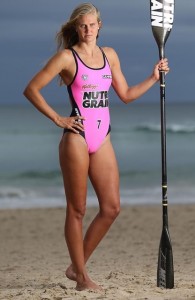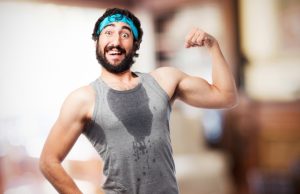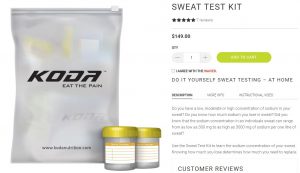Have you had your sweat tested?
By Accredited Exercise Physiologist & Australian Surf Ironwoman, Harriet Brown
Do you experience cramping when exercising or doing activity, or even at rest?
Do you fade towards the end of a race, game or training session?
Do you have stomach issues when competing?
Or are you just looking for an edge to be the best athlete you can be?
A sweat test may be your answer.
 As an Athlete and Exercise Physiologist I have had firsthand experience and seen how a sweat test can help many athletes.
As an Athlete and Exercise Physiologist I have had firsthand experience and seen how a sweat test can help many athletes.
What will a sweat test tell me?
You have a unique sweat rate and you have a unique sodium concentration in your sweat. Sodium is the main electrolyte lost in sweat. Having tested thousands of athletes we have seen how sweat rates (loss of sweat in L per hour) and sodium concentrations vary between individual athletes. A sweat test provides you with important information about the sodium concentration in your sweat as well as your sweat rate. These are your numbers. Your sodium concentration in your sweat does not change so you will only need to do a sodium test once. What does change is the volume of sweat that you lose. The sodium concentration in sweat can vary immensely between athletes. Of the 1500 + tests that have been done the lowest has been 293 mg of sodium per one litre of sweat and the highest 3084 mg of sodium per one litre of sweat. A sweat test can easily be performed by placing special test patches on your arms and exercising for 1 hour at race pace intensity. These test patches are then analysed to give you the sodium concentration in your sweat.
Why are these numbers important?
 When you plan your nutrition and hydration strategy for competition or training, do you just make it up? Do you guess what you need? Have you read a blog online? Or do you replicate what your training partner or coach does because they suggest it?
When you plan your nutrition and hydration strategy for competition or training, do you just make it up? Do you guess what you need? Have you read a blog online? Or do you replicate what your training partner or coach does because they suggest it?
By knowing the sodium concentration in your sweat and knowing your sweat rate in various environmental temperatures you can start to create a more accurate hydration plan of how much to drink, how often and how much sodium to replace. Given we are governed by our stomach and how much it can process while at elevated heart rate you will never replace all that you lose. The plan, especially for long duration events is to bridge the gap as best you can between how much you are losing and how much your stomach can process. A guide is to aim to replace around 50 – 60% of your losses for fluid and sodium.
Why is sodium so important?
Hydration should be replacing what you lose in sweat. Of the electrolytes you lose in your sweat, sodium is the most important. Sodium is extracellular, meaning it is present in your blood, whereas potassium and magnesium are intracellular, meaning they are present in your cells. You lose more sodium than any other electrolyte and sodium loss has the biggest impact on your performance. Therefore, replacing sodium should be the focus of your hydration plan. To highlight how important sodium is, if you are sent to the medical tent with a heat related illness after competition it is most likely you will be given a saline drip. In most instances this will be a Hartmann’s solution, which is a one litre bag of pure water with 3000 mg of sodium, 190 mg of potassium and 0 mg of magnesium. Is the hydration product you are using replacing enough sodium?
Minimise your losses
 The key to a sound hydration plan is to bridge the gap as best you can between how much you are losing and how much your stomach can process. Sweat comes from the water component of your blood. Your blood is made up of approximately 80% water. A reduction in blood volume results in less blood available to your working muscles and also a thickening of your blood. Less blood volume means less efficient delivery of oxygen and nutrients to your active muscles. Blood thickening also means your heart has to work much harder to pump blood around your body.
The key to a sound hydration plan is to bridge the gap as best you can between how much you are losing and how much your stomach can process. Sweat comes from the water component of your blood. Your blood is made up of approximately 80% water. A reduction in blood volume results in less blood available to your working muscles and also a thickening of your blood. Less blood volume means less efficient delivery of oxygen and nutrients to your active muscles. Blood thickening also means your heart has to work much harder to pump blood around your body.
Your sweat rate will change depending on the intensity at which you’re exercising and the environmental conditions. The warmer and more humid the conditions, the more you will need to drink. By testing your sweat rate in various conditions, you will gain a greater an understanding of your sweat rate and how to address this.
Nail your hydration strategy
Over the years, those athletes who have experiences muscle cramping have generally had a higher sweat rate and/or higher sodium concentration in their sweat. By addressing their hydration needs, they are been able to eliminate muscle cramping. If you don’t get your nutrition and hydration strategy right, you may experience cramping, stomach issues, fatigue, dehydration, poor performance and not realise your true potential.
Personally, as an athlete, doing a sweat test and knowing my sweat rate and sodium concentration in my sweat was a game changer when planning my nutrition and hydration for the Molokai to Oahu 52km  Paddle Board World Championships. I felt great throughout the race despite the hot temperatures. I attribute my three race wins and record time to ticking all of the boxes, one being correct hydration and nutrition. The ocean is unpredictable enough, I didn’t want to leave anything else to chance.
Paddle Board World Championships. I felt great throughout the race despite the hot temperatures. I attribute my three race wins and record time to ticking all of the boxes, one being correct hydration and nutrition. The ocean is unpredictable enough, I didn’t want to leave anything else to chance.
You can order a sweat test online at Koda Nutrition Sweating Testing and Contact Harriet at BURLEIGH clinic by phoning 07 5500 6470 for further information.
